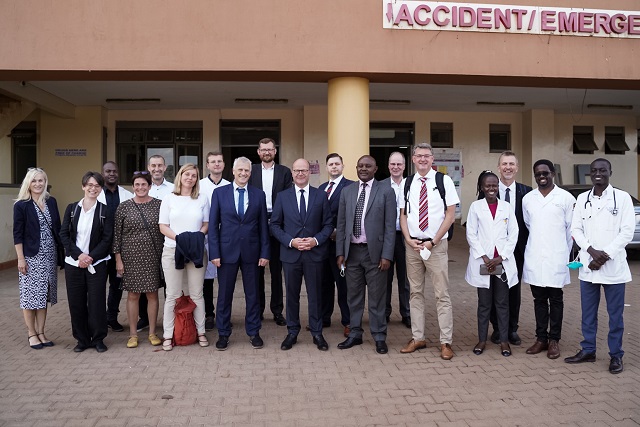
Lack of diagnostic facilities escalates the problem
Kampala, Uganda | Patricia Akankwatsa | The problem of antimicrobial resistance in infectious agents has been rising, and there is global concern that in the absence of interventions to reverse these trends, the means to treat infectious diseases will be limited and out of reach for many, especially those living in low- and middle-income countries.
One of the biggest causes of antimicrobial resistance is the lack of diagnostic facilities which makes targeted treatment impossible, and this has a significant impact on medical care for the majority of patients with infections, especially those with lower incomes.
While visiting Kiruddu Referral Hospital on June 21 to check on the progress of setting up a modern microbiology laboratory, Oliver Schenk, Chief of the State Chancellery and State Minister of Saxony Germany, said that infections and resistance to antibiotics are global health problems that tend to worsen due to the ongoing COVID-19 pandemic and its consequences, particularly in countries with less developed health systems.
“This is why the Leipzig University Medical Centre and in Kampala both the Infectious Diseases Institute at Makerere University and the Kiruddu National Referral Hospital have formed a partnership to draw up a strategy for achieving direct and sustainable improvements in the care of patients with bacterial infections,” he said.
The project is part of the Government and the Federal States Programme (BLP), which is implemented by the Deutsche Gesellschaft für Internationale Zusammenarbeit (GIZ) GmbH on behalf of the German Federal Ministry for Economic Cooperation and Development (BMZ).
The strategy is designed to mitigate collateral damage due to COVID-19 and permanently strengthen the health system. The BLP project is setting up a modern microbiology laboratory at the Kiruddu National Referral Hospital to expand its diagnostic capacity.
According to Dr Michael Klingler, Portfolio Manager GIZ Uganda, microbiological diagnostic testing to identify pathogens and their respective resistance patterns are available to patients with infectious diseases in Kampala (Uganda) only as part of a scientific study or for a very small group of patients paying for themselves.
“The procedure for sending off samples for testing is complicated, and this delays the results,” he said.
Dr Charles Kabugho, the executive director of Kiruddu referral hospital said he was honoured to have this partnership because the new microbiology laboratory will help in quick diagnosis.
“The laboratory came with a VITEK machine for diagnosing infections faster. Our microbiologists have attested to that. We now get results in 24 hours or less.”
The Ministry of Health Annual Health Sector Performance Report for 2020/2021 indicates that antimicrobial resistance is the second leading cause of hospital admission deaths, accounting for 2,944 mortalities. At least 45,042 people died in hospitals in 2019/2020 while in 2020/2021, the number increased to 45,990.
 The Independent Uganda: You get the Truth we Pay the Price
The Independent Uganda: You get the Truth we Pay the Price



Now we look forward to comparison of:
the standard of isolating an infectious agent from a disease process and determine its susceptibility to antimicrobial agent ( culminating into a data base to inform empiric treatment)
with
the information from the blood picture, where predominance of a cell of acute inflammatory response is equated to bacterial infection. And the treatment is from best guess!!
Is this an :innocent” driver of resistsnce?
Awareness, so near yet so far away
This is how I used to understand referral
While growing up in a village there was a kitawuluzi ( ? Village level site to handle issues) then parish, subcounty and County levels , from the subject called ” civics” There was flow of information from lower to higher level and the reverse direction when necessary.
So if Kiruddu is a referral hospital then there are lower health facilities that manage patients and certain number end up requiring to go to Kiruddu hospital
Uganda has a list of the commonest Infectious Diseases and in the case of TB the detection and confirmation of antimicrobial resistance for clients who visit health facilities is quite stream lined
How many cases of fever, where the one treating a patient condifers a possible bacterial infection get a sample from the disease related area to the laboratory before beggining treatment?
Investigation to those who can afford, ( may be), but are we aware of the roles of the central public health laboratory? However this system is likely to work if the first contact with health care is facilitated to know why investigate? The best sample to collect a fast means of delivery to a public laboratory with corresponding delivery of results
Now in this city of five divisions, those who cannot afford should go to public health facilities. The description of Kaeempe Division, the one of a predominantly poor population makes the analysis interesting
How many public facilities are located in the catchment area? Are they in position to investigate infection in clients who are not sick enough to go to Kiruddu?
It is claimed that health is made at home and only repaired in hospital. The germs that make us sick get exposed to antimicrobial agents in the community then those who get treated in hospital bring more sophiscated resistance to the community.
Where are the messages that target community exposure to antimicrobial agents, and those that target the control of spread of resistance in the communities?
Hopefully when such messages arrive they will be delivered in a way that facilitates easy understanding by the community
This antimicrobial resistance story is quite sporadic, yet the problem is big,, we need sustained action within our means.
The word bacterial infection has become so common among those who return from health facilities. They also come back with a plastered hand and keep in that state until completion of a dose of the drug called “Sefu”
Now there is a saying that the right client will receive the right drug: dose frequency and duration taken into consideration
The question is what germ is being treated, and is it likely to be killed by “Sefu” all the time it is given?
Is there a possibility of “Sefu” turning out to suffer the fate of “Salufa” ; just like the medicine against ticks its use no longer delivers the desired out come
This takes us to the original article where the need to enhance diagnostic capacity should be one of the priorities. However it should be at all levels of care
To begin with if antimicrobial resistance is associated with a poor outcome, then we should be seen to determine its trends and also minimise practice that worsens the situation.
So the client to receive Medicine should tell a story about the sickness and answer questions to complete the picture. He then gets examined. If he has infection he should have a sample taken before starting on a drug. When results show that he needs another drug or his conditions demands, then the treatment is adjusted appropriately
The results from the sample ( taken from the client,) do not only benefit him/ her but contribute informtion on the common germs and the good drug to use ( call it”G”)
That drug “G” becomes the drug to use for the same condition in other clients suspected to have the same germ
The current practice does not tell us of the effectiveness of “Sefu” and as such if some germs are already able to destroy “Sefu” ( call them “B”) its use makes the situation worse by ensuring that only those that destroy it “B” survive. These subsequently move from person to person because our hygiene and sanitation practices remain wanting
Next time germ “B” gets into your blood, the outcome may be very bad because “Sefu” will not work
As those who cannot afford report to public facilities, let the sample go to a place that can handle public samples
If germs move from person to person and a proportion of such germs are capable of destroying drugs that were meant to kill them then minimising the movement may contribute to reduction of the burden of antimicrobial resistance
Other than the measures to stop the transmission of Covid-19 we already had.measures to control diarrhoea disease
The community have realised that during the recent waves of Covid-19 , when control measures eete implemented.it ted to the decrease in numbers of individuals suffering from conditions like cough and diarrhoea
It is possible that messages that contribute to reduction in exposure to antimicrobial drugs will add to slowing the speed at which the germs get used and prepare to destroy these drugs
Let the institutions that appeal to varied communities develop interest in this component
Puzzling indeed, a respectable practitioner has observed that the status of health financing may not support the diagnostics that are optimal to ensure sustainable detection of antimicrobial resistance on public facilities
Now if the reports associate the monster with poor outcome, at what point will these committees currently visiting hospitals and asking about funds returned to the centre pick this funding gap?
The chair of a certain committee should interest himself in this issue; incidentally one report pointed to these Uganda based bugs to be among the problems that complocate specialised care in patients seeking treatment abroad